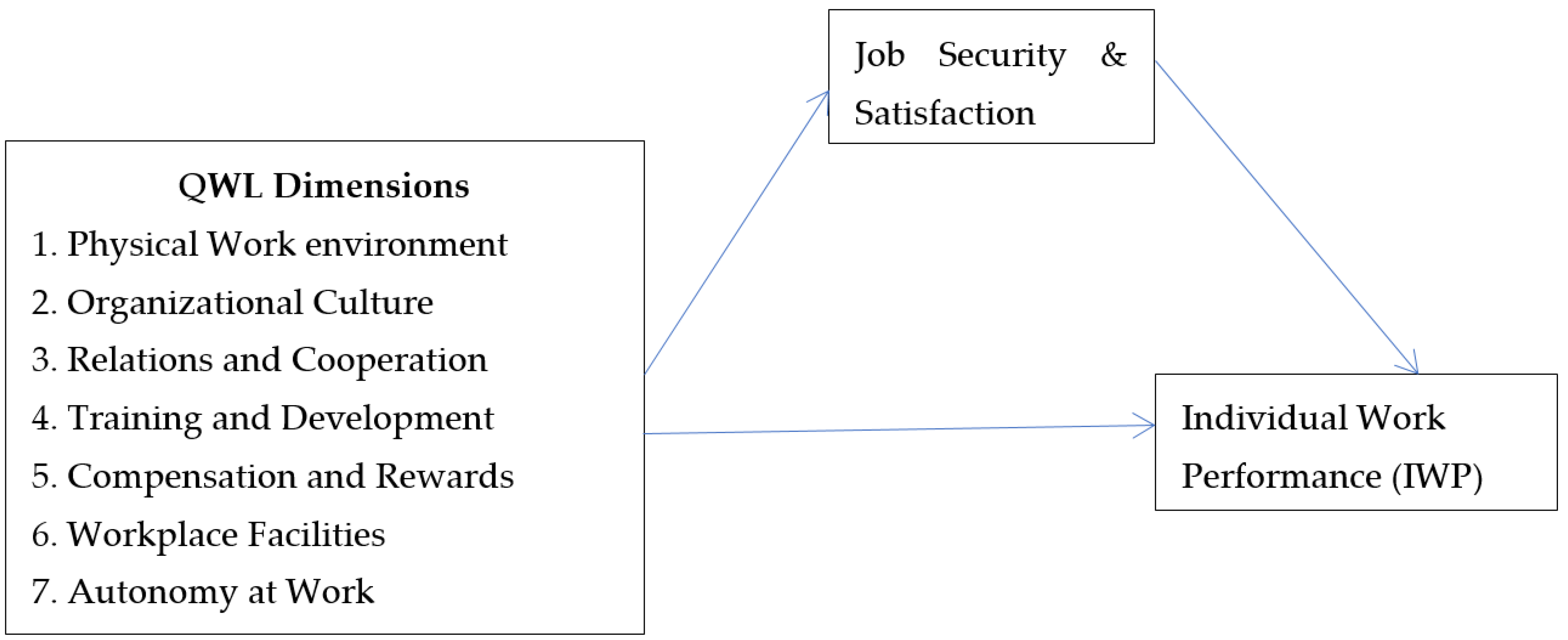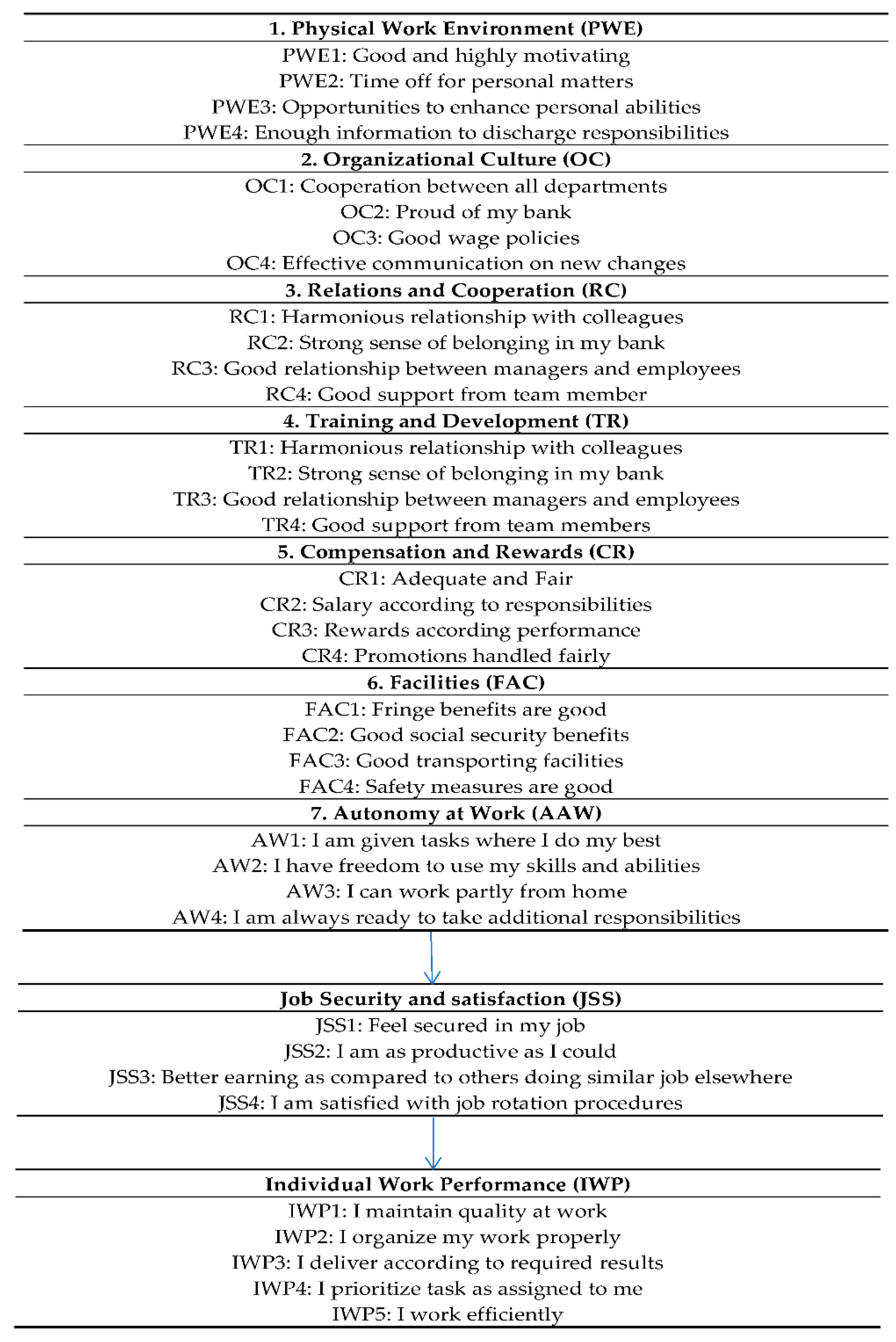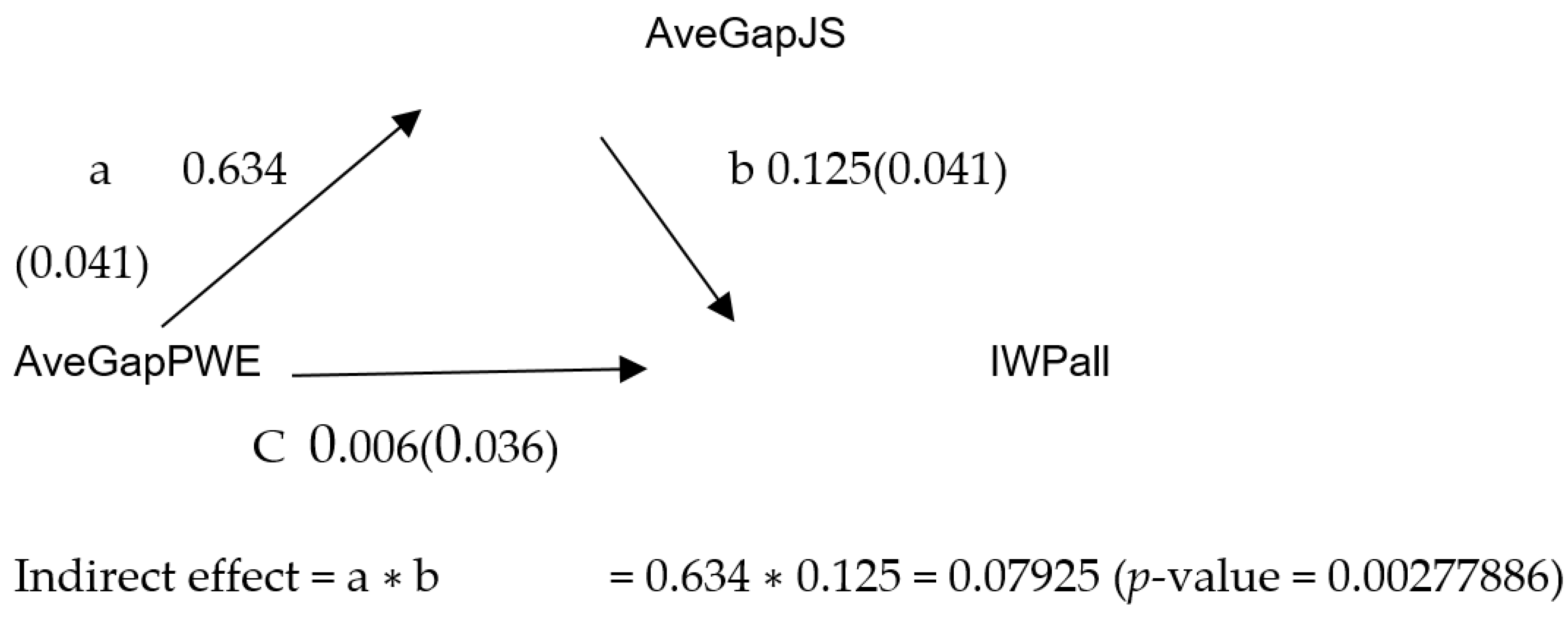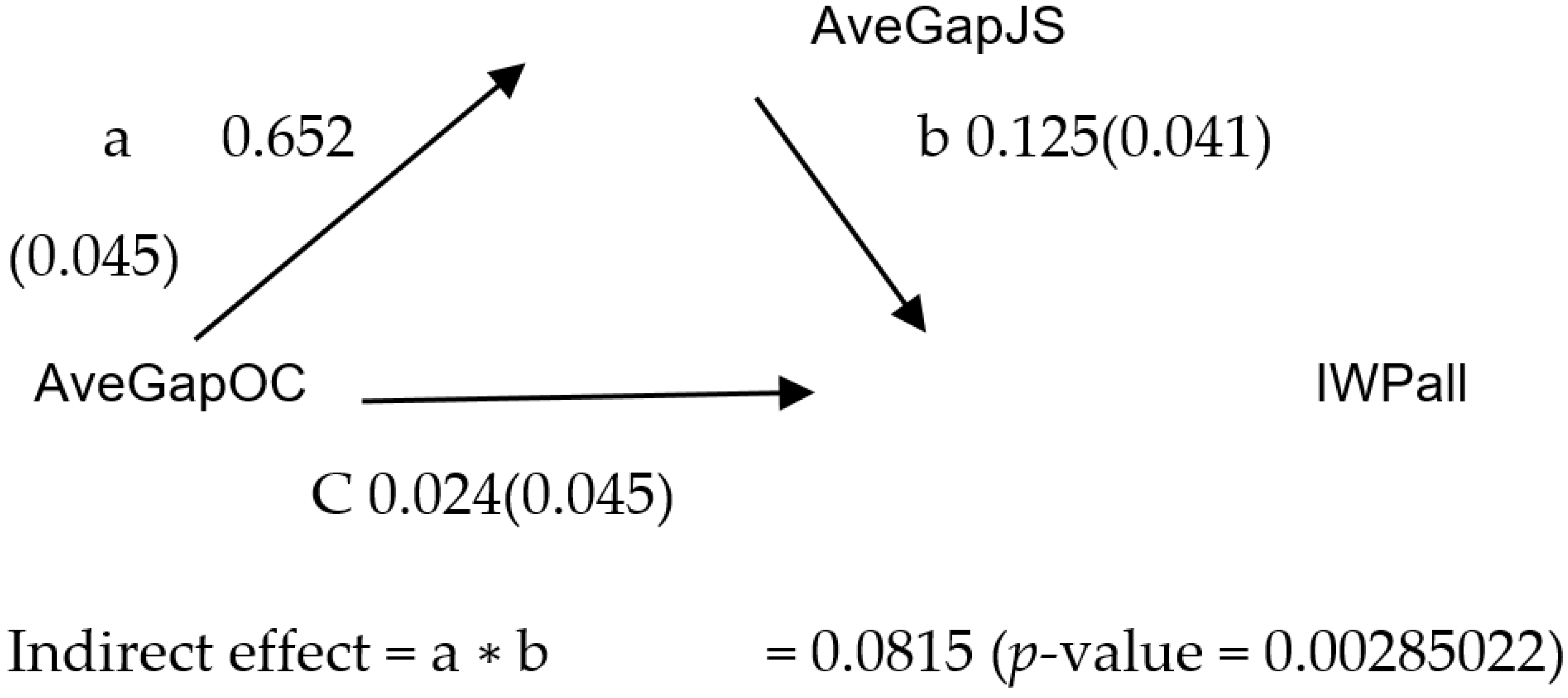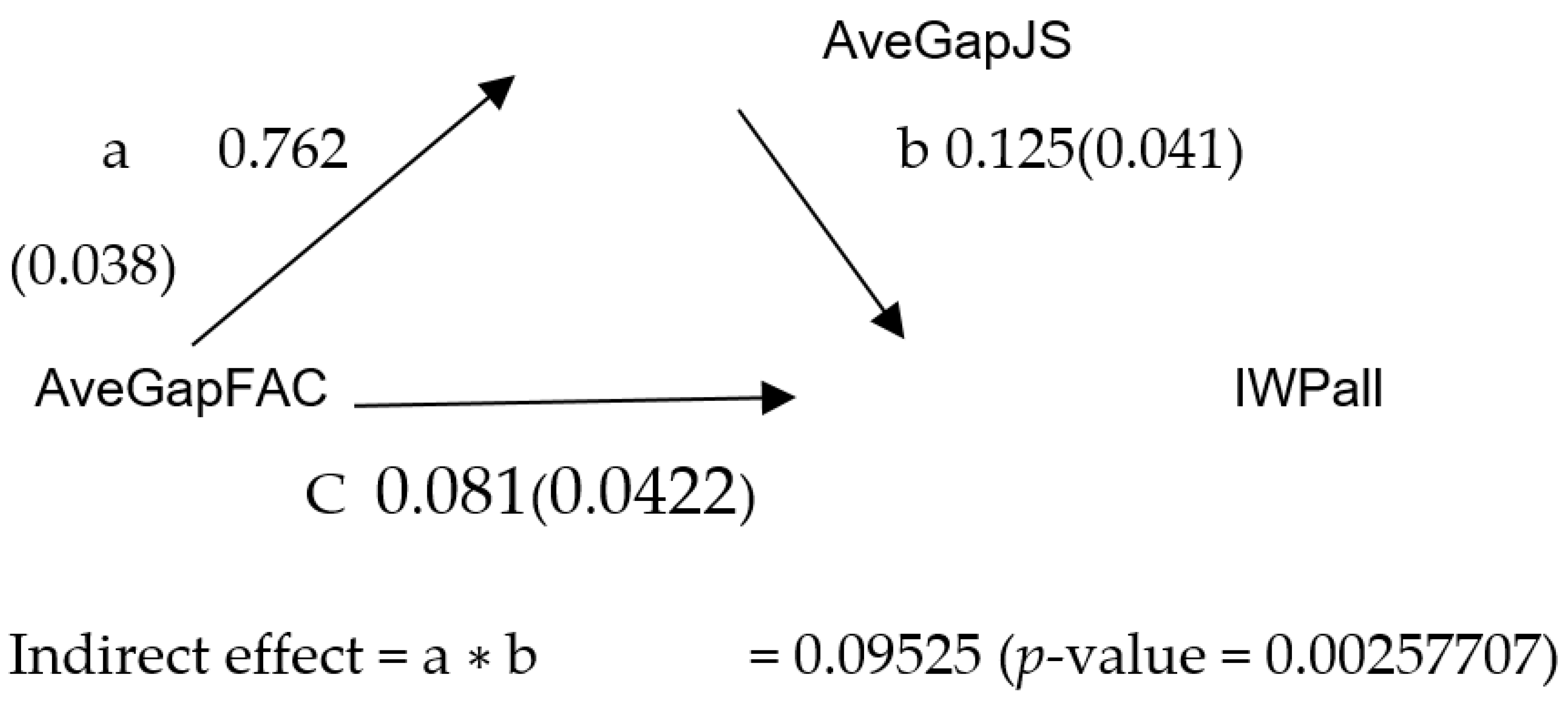This research passed through the following stages.
3.1. Stage One: Literature Review
An extensive literature review helped us to understand and put together the dimensions and subdimensions of QWL and to examine their influence on individual work performance. Literature reviews also led us to understand the relevance of QWL factors in the Saudi banking industry. The core issue of this research is to elaborate on the impact of the relationship between an organization and its employees. This concept is not new and has been highlighted by
Lawler (
2005). However, the application of WRKLFQUAL in the case of Saudi banking provides a new dimension to establish a relationship between Saudi banking management and their employees. In this respect, employee satisfaction requires employees to have certain expectations fulfilled so they will remain loyal to their organizations (
Woods 1993;
Conlon 2003;
McDonald and Hite 2005). In this perspective,
Kotzé (
2005) provided a very strong notion: “employees who commit themselves fully to achieving the organization’s objectives should also experience a High Quality of Work Life”.
Quality is essential for sustained organizational growth—whether it is service delivery or work life (
Spreng and Mackoy 1996;
Ishfaq et al. 2020). Accordingly,
Saraji and Dargahi (
2006) argued that QWL has the same impact on sustained organizational growth as the quality of product or service has. They further argued that employers have to recognize that workforces have lives before and after work that must be taken into consideration. Hence, QWL, with its variety of dimensions, is a focal point of our study. Most researches with reference to QWL concentrate on healthcare services (
Cole et al. 2005;
Saraji and Dargahi 2006;
Nadler and Lawler 1985). Accordingly, studies have mainly focused on QWL factors and their impact on job satisfaction or organizational performance. Among various models, we found Walton’s QWL model (1975). Presented by
Timossi et al. (
2008), to be quite relevant to our study in measuring the quality of work life.
Walton’s (
1973) study offers eight evaluation criteria with 27 QWL sub-criteria, which we consider to be very close to our seven WRKLFQUAL dimensions and 28 subdimensions. There are some studies with reference to the banking system that present relations between job satisfaction and QWL dimensions (
Buvaneswari 2011;
Daljeet 2010). With reference to the service industry,
Lau (
2000) explored the links between performance, profitability, and quality of work life. We believe that job satisfaction relies on QWL, and many researchers have a similar belief—for example
Huselid (
1995);
Chan et al. (
2000);
Koys (
2001);
Ellinger et al. (
2002);
Mafini and Pooe (
2013); and
Latif et al. (
2015). The same is also argued by
Mamedu (
2016) with reference to the “perception of Quality of Work-Life and University Goal Attainment”. We also learned from the literature that organizational success greatly relies on employee efforts to improve service quality, and this is consequently achievable with QWL according to employee expectations (
Narang and Singh 2016). Therefore, we conclude from the above discussion that QWL, job performance, and profitability are significantly linked. Therefore, profitability can by no means be achieved without the required IWP.
With reference to bank performance, some studies from different angles are worth mentioning here because they support our paradigm that QWL helps justify bank executives being motivated toward risk-taking. Positive QWL can increase bank efficiency and reduce the need for hedging (
Belkhir and Boubaker 2013;
Boubaker et al. 2022;
Samet et al. 2018). Although these papers are in different contexts, nevertheless, they have significant potential in explaining that QWL has a deep impact on bank performance. This is what we are focusing on in the case of Saudi banking performance through QWL, as well as with respect to combining its outcomes with the mediating process.
Now the question arises of how to determine QWL. The solution was presented by
Kandasamy and Sreekumar (
2009) in their study using WRKLFQUAL as a tool for measuring QWL. Based on gap analysis methodology,
Kandasamy and Sreekumar (
2009) determined the difference between expected QWL (EQWL) and perceived QWL (PQWL). Their study basically applied the model of
Parasuraman et al. (
1988), as provided below.
We adopted the same model of QWL (Equation (1)) in the form of WRKLFQUAL, as follows:
Here, EQWL is the expected quality of work life, and PQWL is the perceived quality of work life.
Having discussed the model and the necessary dimensions of QWL in the literature review, in
Figure 2, we present the seven dimensions of QWL and the sub-dimensions (number of items) to be used in the WRKLFQUAL model.
Note that JSS and IWP (
Figure 1) have not been included in the WRKLFQUAL analysis, as we plan to determine the impact of gaps in JSS and IWP separately.
Based on the above model of determining QWL, in line with those of SERVQUAL, we plan to apply its outcome to examine the relationship between gaps in QWL and JSS and finally study the mediating role of JSS in IWP. This will provide a new dimension in the theoretical framework of gap analysis and its further implications for organizational performance. This is the major contribution we are making to the literature, that is, that the outcome of gap analysis can by combined to study the mediating role between the quality of service or quality of work life and organizational profitability.
3.2. Stage Two: Questionnaire Development and Data Collection
Based on the literature review, we expanded the dimensions into the subdimensions of QWL (
Figure 2), and, accordingly, a questionnaire was developed to collect primary data from employees of the Saudi banking sector. Our focus was on national banks and multinational banks operating in the KSA in order to determine GQWL (gaps in QWL) and their impact on employee work performance. The questionnaire is provided in
Supplementary Materials. We ensured that the questionnaire was well understood by adding an Arabic translation so that we could obtain correct answers. The questionnaire was administered by research assistants under the supervision of a senior academic. The data were collected from a sample of 300 out of the 350 targeted banking employees in Jeddah. The response rate was around 86%, which we consider quite satisfactory.
The validity of the questionnaire’s content was confirmed by distributing it to around 10 experts to offer their opinion on whether the respondents would be able to understand and complete the questionnaire correctly. The participants rated the questionnaire items on a Likert scale of 1 to 5, where 5 stands for the highest rating and 1 indicates the lowest rating for the quality of work life (
Gržinić 2007).
The collected data were input into SPSS software for both analysis and interpretation. The statistical tests were then carried out to assess the reliability and quality of the data. Finally, a factor analysis was carried out, and gaps in QWL were determined. A profile analysis of the Saudi banking workforce is provided in
Table 1.
The Saudi workforce is quite sophisticated and expects the best quality from its work environment.
Table 1 depicts a fairly balanced demographic structure of the sample. Around 69.2% of the population is between the ages of 26 to 50 years, which means the large sample size is young, vibrant, physically active, and willing to perform well, provided they perceive QWL to be up to their expectations. Male and female employees in the sample almost equally seek positive QWL. A large percentage of the sample comprises Saudi nationals with a good level of education. Similarly, the sample’s position on job levels and income levels, and its presence in Saudi and non-Saudi multinational banking sectors, is fairly normal. This suggests that expectations and perceptions of QWL across the banking sector are highly uniform.
3.5. Stage Five: Gap Analysis
Lassar et al. (
2000) argued in their study of “service quality perspectives and satisfaction” that consumer satisfaction relies on the quality of service or product. Here, we put forward the same paradigm with a small modification, that is, that employee job satisfaction is conditional on the quality of work life. Accordingly, based on Equation (3), we present gaps in the quality of work life (GQWL) in
Table 5.
It is clear from
Table 5 that the dimensions and subdimensions have negative gaps that can cause employee job dissatisfaction and eventually negatively influence individual work performance (IWP). Although we can say that gaps are quite trivial. they indicate that management should focus on issues and make efforts to improve their employees’ quality of work life.
Table 6 presents unweighted average scores showing almost all areas of work life need some attention.
This analysis can be further refined by calculating weighted gap scores, as provided in
Table 7.
The weighted average scores in
Table 7 suggest that employees give almost equal weight to all dimensions of QWL; therefore, gaps in any dimension could cause employee dissatisfaction, eventually having a negative impact on IWP. Keeping a close eye on weighted scores, we see that TR, with a weighted score of 15.8%; FAC, with a weighted score of 15.6%; CR, with a weighted score of 15.5%; and RC (relation and co-operation) are considered more important by employees. Hence, we accept that there are gaps between expected QWL and perceived QWL—as mentioned in the first objective of this research.
3.7. Relationship between QWL and JSS
The second objective of this research was to analyze and identify a correlation between GQWL (gaps in QWL) and job security and satisfaction (JSS). In this context,
Kermansaravi et al. (
2015), citing Mirkamali and Narenjisani 2008 and Armstrong 2006, argued that, from 1980 to 2006, most research studies found a positive relationship between QWL and job satisfaction.
Royuela et al. (
2009) argued that “QWL is one of the most important factors for human motivating and improving job satisfaction”. There are many studies around the globe about job satisfaction and QWL; however, studies determining the relationship between QWL and job satisfaction in Saudi Arabia are quite limited. Accordingly, we conducted a regression analysis between QWL and JSS and present a correlation between the seven dimensions by considering them as predictors in
Table 9.
Table 9 shows a correlation between the average gaps of all dimensions and that they are significantly and positively correlated, ranging from 0.625 to 0.812. Further regression analysis results are presented in
Table 10.
The above results provide robust evidence to support applying WRKLFQUAL, a gap analysis tool for measuring quality of work life (
Kandasamy and Sreekumar 2009). The multiple regression equation applied in our case is:
where
Yt is JSS (job security and satisfaction),
b0 is
Y intercept,
b is the coefficient of regression, and
et is an error of the estimate. An R
2 of 0.704 suggests that we have a good-fitting model. Thus, we can conclude that JSS is an inverse function of the average gaps in all dimensions, as follows:
Since the gap scores are negative, we thus infer that, as gaps increase (dimensions move away from zero towards negativity), the JSS decreases. If all gap scores approach zero, then the quality of work life will result in job satisfaction. Hence, we accept that gaps have a strong impact on job security and satisfaction—the second objective. In fact, JSS increases as gaps decrease.
3.8. Relationship between GQWL and IWP, JSS Playing Mediating Role
The final objective of this research was to look at the relationship between GQWL and IWP, with JSS playing a mediating role. Many studies have provided evidence that the relationship between individual job satisfaction and individual work performance does exist (
Petty et al. 1984;
Kermansaravi et al. 2015;
Bakotič 2016;
Shmailan 2016). Our research is unique in the sense that many behavioral scientists use mediating studies in their behavioral science research, for example, the mediating role of job satisfaction between personality and citizen behavior (
Ilies et al. 2009) and the mediating role of job satisfaction toward the organizational commitment of employees in the public sector (
Ingsih et al. 2020).
Our study uses a different approach by combining gap results to mediate the process. Since the quality of work life has an impact on IWP to a great extent, we will therefore briefly explain how our research found that JSS plays a mediating role between GQWL and IWP. The
Baron and Kenny (
1986) protocol explains the testing of mediating effects, and the same was applied in this research. The theoretical model in this respect is presented in
Figure 1.
The first step in this respect was to carry out regression analysis, as presented in
Table 11.
From
Table 11, it can be seen that R
2 is 0.759, slightly higher than R
2 0.704 in
Table 10. This suggests that we have a good-fitting model. F value 115.291 is also substantially high, with a significance level of 0.000. Here it is worth discussing that we used eight predictors, with IWP being dependent on eight of those predictors, including JSS.
Table 12 suggests that all predictors are significant except AveGapPWE, AveGapOC, and AveGapFAC, their significance values being 0.858, 0.603, and 0.055.
Having completed this process, we now turn toward the mediating impact of JSS between GQWL and individual work performance (IWP). As mentioned earlier, there are a number of studies proving the relationship between individual job satisfaction and individual work performance; here, our purpose is to make use of WRKLFQUAL through gap analysis and statistically prove that quality of work life influences IWP, with job satisfaction playing a mediating role.
Baron and Kenny (
1986) proposed a three-step procedure to determine the role of the mediating element. In our case, we have eight predictors, i.e., the average gaps (GQWL) presented in
Table 5. It would be difficult to perform a mediating procedure on all eight predictors and dependent variables, i.e., IWP (individual work performance). However, we took the first three predictors to explain how the mediating role can be identified. Accordingly, we found that JSS (job security and satisfaction) significantly mediates the gap in quality of work life and individual work performance. Some of our analyses are presented as follows.
The first analysis was to find the mediating role of JSS in AveGapPWE and IWP via that Sobel test, making use of SPSS. The result of Sobel test is presented in
Figure 3.
There is a clear indication from the above statistics that the Sobel test (2.991) result was higher than 1.98, which is the minimum criterion for Sobel to be significant and effective. Furthermore, this probability value was also less than 0.05. Thus, the null hypothesis was rejected and a significant indirect effect was found. This indicates that AveGapJS has a mediating role in AveGapPWE and IWP.
Similarly, the second analysis was to find the mediating role of JSS in AveGapOC and IWPall. The result of Sobel test is presented in
Figure 4.
The above statistics indicated that the Sobel test result (2.983) was higher than 1.98, which is the minimum criterion for Sobel to be significant and effective. Furthermore, this probability value was also less than 0.05. Thus, the null hypothesis was rejected and a significant indirect effect was found. The above result explains that AveGapJS has a mediating role in AveGapOC and IWPall.
The third analysis was to find the mediating role of JSS in AveGapFAC and IWP. The result of Sobel test is presented in
Figure 5.
The study applied the Sobel test to measure the mediating role of AveGapJS in AveGapFAC and IWPall. The above statistics of the Sobel test show that the result, 3.014, was higher than 1.98, which is a clear indication of mediation. Thus, we rejected the null hypothesis and accepted the alternative hypothesis.
We have presented a Sobel test for three types of analysis, and we could have continued Sobel testing for all eight predictors; however, we inferred that JSS would show clear indications of mediation for the remaining predictors and felt no need to carry out further analysis.
